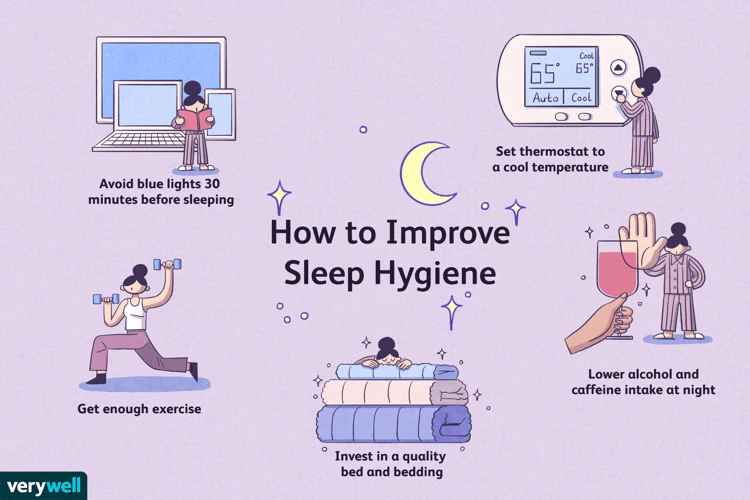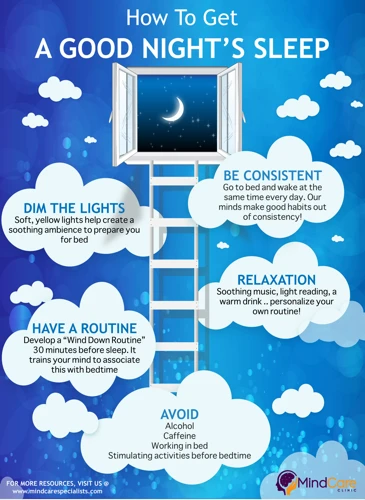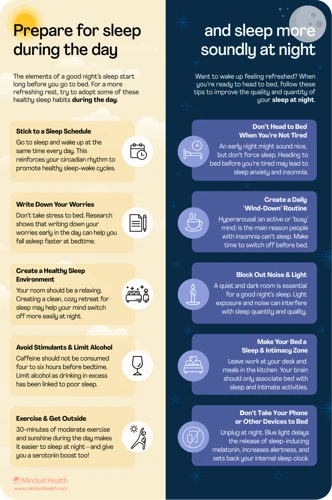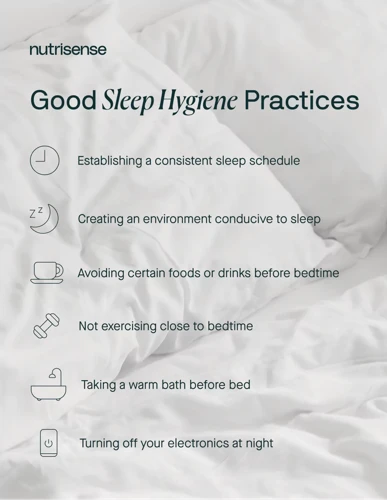The Importance of a Bedtime Routine

Developing a consistent bedtime routine is essential for achieving restful and consistent sleep. Without a bedtime routine, you may find yourself struggling to fall asleep or experiencing frequent interruptions to your sleep. A bedtime routine can help prepare your mind and body for sleep, making it easier to fall asleep and stay asleep.
One of the key benefits of having a bedtime routine is that it establishes a sense of predictability and consistency. When you go to bed and wake up at the same time every day, your body becomes accustomed to this routine and begins to naturally regulate your sleep-wake cycle. This can lead to improved sleep quality and increased energy and alertness during the day.
Additionally, creating a bedtime routine can help you relax and unwind before bed. By engaging in soothing activities like reading or meditation, you can signal to your brain that it’s time to wind down and prepare for sleep. This can be especially helpful if you tend to feel stressed or anxious at night, as a bedtime routine can provide a sense of calm and structure.
Incorporating a bedtime routine into your daily routine can have numerous benefits for your health and wellbeing. Not only can it improve the quality of your sleep, but it can also help you feel more rested and alert throughout the day. So, take the time to create a bedtime routine that works for you and stick with it consistently for better sleep and overall wellness.
Step 1: Set a Consistent Bedtime and Wake Time

As you start thinking about improving your sleep routine, one of the most fundamental steps to take is establishing a consistent bedtime and wake time. This may sound simple, but it requires some planning and attention to your body’s natural rhythms. In this segment of the article, we’ll discuss how to determine your ideal bedtime and wake-up time, and explore the benefits of sticking to a consistent sleep schedule. So let’s dive in and explore the first step toward creating an ideal bedtime routine for better sleep.
Why Consistency is Key
Consistency is a fundamental aspect of maintaining a healthy and consistent sleep routine. When you establish a regular sleep pattern, your body adjusts to it, making it easier to fall asleep and wake up at the same time every day. This is because your body regulates your internal clock, also known as your circadian rhythm, based on the patterns you establish in your life. When you go to bed and wake up at the same time every day, your body adapts to this routine and signals when it’s time to sleep or wake up.
On the other hand, an inconsistent sleep routine can disrupt your circadian rhythm, leading to difficulty falling asleep and waking up, and ultimately, poor sleep quality. When your body doesn’t know when to sleep, it can’t prepare itself for sleep, leading to sleep deprivation and other negative effects on your physical and mental health.
To understand why consistency is key to a good sleep routine, it’s important to realize that sleep is not just about quantity, but also quality. Inconsistent patterns can lead to poor quality sleep, which often means waking up feeling groggy and unrested, even if you’ve slept for a long time. By setting a consistent bedtime and wake-up time, you can establish a routine that promotes deep, restful sleep that helps you wake up feeling refreshed and energized.
To summarize, consistency is key to maintaining a healthy and consistent sleep routine. It allows your body to regulate your internal clock and prepare for sleep, which ultimately leads to better quality sleep and more energy throughout the day. By sticking to a regular bedtime and wake-up time, you can establish a routine that promotes good sleep, and this should become an essential component of your overall health and wellness routine.
| Key Points |
|---|
| Consistency is fundamental to establishing a healthy sleep routine. |
| A regular sleep pattern makes it easier to fall asleep and wake up. |
| An inconsistent sleep routine can disrupt your internal clock and lead to poor quality sleep. |
| Quality is just as important as quantity when it comes to sleep. |
| Sticking to a regular routine promotes deep, restful sleep and more energy throughout the day. |
How to Determine Your Ideal Bedtime
Determining your ideal bedtime can be a challenge, but it’s essential for a consistent and uninterrupted sleep. Here are some tips to help you find your perfect bedtime:
- Calculate your sleep needs: It’s recommended that adults get between 7-9 hours of sleep each night. Calculate what time you need to wake up and count backwards to determine your ideal bedtime. For example, if you need to wake up at 6 am and require 8 hours of sleep, your bedtime should be 10 pm.
- Experiment: Keep track of your sleep pattern for a week or two, adjusting your bedtime until you find the perfect window. Consider how you feel when you wake up and how long it takes to fall asleep at night.
- Listen to your body: Pay attention to your body’s signals. If you feel drowsy during the day or struggle to wake up in the morning, it may be a sign that you’re not getting enough sleep.
- Consider your lifestyle: Your bedtime should align with your lifestyle. If you have an exercise routine or demanding job, make sure to factor in enough time to unwind before bed.
- Stick to your routine: Once you have determined your ideal bedtime, commit to sticking to it every day, even on weekends. Consistency is key to a successful bedtime routine.
By following these tips, you can find the ideal bedtime that works best for you and your lifestyle, leading to a better night’s rest and more productive days.
Waking Up Naturally with the Right Time to Bed
When it comes to waking up naturally, setting the right time for bedtime is crucial. It may be tempting to stay up late or sleep in on the weekends, but doing so could disrupt your body’s natural sleep rhythm. Here are some tips for determining your ideal bedtime:
- Calculate Your Sleep Needs: The amount of sleep you need varies by age, with adults typically requiring 7-8 hours per night. Take into consideration your personal sleep patterns and adjust accordingly.
- Consider Your Schedule: If you have to wake up early for work or other obligations, plan to go to bed earlier to ensure you get enough sleep.
- Listen to Your Body: Pay attention to how you feel in the mornings. If you are consistently waking up feeling groggy or tired, it may be time to adjust your bedtime.
- Experiment: Try going to bed at different times and see how you feel in the morning. Keep track of your sleep and mood patterns to find the optimal bedtime for you.
By setting a consistent bedtime that allows you to wake up feeling rested and alert, you can establish a more consistent sleep schedule and improve your overall sleep quality.
Step 2: Create a Relaxing Environment

When it comes to getting a good night’s sleep, the environment in which you sleep plays a significant role. Creating a relaxing environment can help ease your mind, reduce stress, and promote a sense of calmness. This, in turn, can help improve the quality of your sleep and make it easier to fall asleep. In this section, we’ll explore how to create a bedroom atmosphere that promotes relaxation and restfulness through the use of various strategies, such as decluttering, setting the right temperature, and maximizing comfort with the right bedding.
Declutter Your Bedroom
When creating a bedtime routine for consistent sleep, it’s important to create a relaxing environment in your bedroom. One of the first steps in achieving this is to declutter your bedroom. A cluttered bedroom can cause stress and anxiety, making it more difficult to fall asleep and stay asleep. Here are some tips to help you declutter your bedroom:
| Create designated storage areas: | One major cause of clutter in bedrooms is clothing and accessories left out in the open. Consider investing in dressers, closet organizers, and other storage solutions to keep your clothing and accessories organized and out of sight. |
| Eliminate unnecessary items: | Take some time to go through your bedroom and remove any items that you no longer need or want. This could include old magazines, books, or decor that no longer matches your style. Donate or toss these items to free up space and reduce clutter. |
| Keep surfaces clear: | A cluttered nightstand or dresser can make your bedroom feel chaotic. Try to keep surfaces clear by only placing necessary items like a lamp, book, or glass of water. |
| Use calming colors: | When choosing decor items for your bedroom, consider using calming colors like blues, greens, or pastels. These colors can help create a peaceful atmosphere and promote relaxation. |
By decluttering your bedroom, you can create a peaceful and relaxing environment that is conducive to a good night’s sleep. Don’t underestimate the impact that clutter can have on your mental state and overall well-being. Take the time to organize and simplify your bedroom to support your sleep hygiene and overall health.
Set the Right Temperature
Ensuring that your bedroom is at the right temperature is essential for a good night’s sleep. If the room is too hot or too cold, it can interfere with your body’s ability to regulate its internal temperature, which can disrupt your sleep. Here are some tips to help you set the right temperature for a good night’s sleep:
- Keep the room cool: The ideal temperature for sleep is between 60 and 67 degrees Fahrenheit (15.6 and 19.4 degrees Celsius). Keep your bedroom cool by opening a window, using a fan or air conditioning, or using a combination of these methods.
- Use breathable bedding: Opt for bedding made of breathable materials like cotton and linen, as they allow air to circulate and prevent heat from getting trapped.
- Avoid thick blankets: Using a thick blanket may feel cozy at first, but as your body temperature rises during sleep, you may wake up feeling too hot. Instead, use a lighter blanket or choose a thicker blanket made of breathable materials.
- Adjust for personal preference: While the recommended temperature range is between 60 and 67 degrees Fahrenheit (15.6 and 19.4 degrees Celsius), everyone’s ideal sleep temperature may vary slightly. Experiment with different temperatures to find what feels most comfortable for you.
By setting the right temperature in your bedroom, you can help ensure that your body is able to relax and achieve the restorative sleep it needs.
Maximize Comfort with the Right Bedding
When it comes to creating the ideal bedtime routine for consistent sleep, maximizing comfort with the right bedding is crucial. Here is a list of recommended bedding options that will help you achieve that:
- Invest in a quality mattress: A good mattress is the foundation of a good night’s sleep. Look for one that provides both support and comfort for your body.
- Choose the right pillow: Your pillow plays a big role in how well you sleep. It should support your head and neck in a neutral position. Consider a pillow made with memory foam, down, or buckwheat.
- Get cozy with a warm blanket: As the temperature drops at night, it’s important to have a warm blanket to snuggle up with. Look for blankets made from materials such as fleece, wool, or down that will keep you warm without overheating.
- Select breathable sheets: Breathable sheets are important for regulating body temperature and preventing moisture buildup. Look for sheets made from materials such as cotton or bamboo.
- Use comfortable bedding layers: Consider layering your bedding with a soft mattress topper or a down comforter to provide added comfort and warmth.
By investing in quality bedding that meets your personal comfort needs, you’ll be setting yourself up for a good night’s sleep. Remember, comfort is key when it comes to consistent sleep.
Step 3: Wind Down with Soothing Activities

As bedtime approaches, it’s important to shift your focus from the hectic events of the day to a more calming state of mind. One of the most effective ways of doing this is through winding down with soothing activities. This step in your bedtime routine will help your mind and body to relax, paving the way for a restful night’s sleep. However, not all activities are created equal when it comes to promoting relaxation, and some may even have the opposite effect. So, it’s crucial to choose activities that are gentle on both the mind and body. To help, this section will introduce you to effective ways to unwind and prepare for sleep.
Avoid Strenuous Activities Before Bed
It’s important to avoid strenuous activities before bed to promote quality sleep. Consider reducing physical activity at least two hours before going to bed to allow your body to wind down. Here are a few relaxing activities you can try instead:
- Mindful meditation: This relaxing practice helps to calm your mind by focusing on your breath and is a great way to end your day without over-stimulating your brain.
- Yoga: Practicing gentle yoga poses before bed can help to stretch tense muscles and reduce stress, preparing you for a good night’s sleep.
- Reading: Picking up a book or a magazine can be a relaxing way to end your day, allowing your mind to focus on something other than your to-do list.
Engaging in stimulating activities right before bedtime can stimulate your brain and make it difficult to fall asleep. Examples of such activities include vigorous workouts, video games, or engaging in work-related tasks that rev up your mind. By avoiding these activities and instead choosing calming ones, you are more likely to have a peaceful and restful night’s sleep.
Relax Your Mind with Mindful Meditation, Yoga or Reading
When it comes to winding down before sleep, it’s important to engage in activities that help you relax and clear your mind. Mindful meditation, yoga, and reading are all great options for achieving this. Here are some more details on each:
- Mindful Meditation: This involves focusing your attention on the present moment and becoming aware of your thoughts and emotions without judgment. This can be done through guided meditation sessions, apps or it can be as simple as focusing on your breath.
- Yoga: Practising yoga before bed can help to release tension in the body, allowing it to relax and promote better sleep. Poses such as child’s pose or legs up the wall are great options for a pre-bedtime yoga session.
- Reading: Enjoying a book or magazine can help you to switch off from the stresses of the day and transport you to a calmer state of mind. However, it’s important to read something that’s not too stimulating or exciting, as this can have the opposite effect and keep you up at night.
It’s important to note that everyone is different, so what works for one person may not work for another. Experiment with these activities and find what makes you feel relaxed and ready for sleep. It may also be helpful to incorporate other practices like deep breathing, progressive muscle relaxation or journaling into your routine. The key is to find what works best for you and make it a consistent part of your bedtime routine.
Step 4: Limit Blue Light Exposure

As we become more reliant on technology in our day-to-day lives, it’s important to understand its impact on our sleep quality. Electronic devices emit blue light, which can disrupt our body’s natural production of melatonin and make it harder for us to fall asleep. However, limiting blue light exposure is easier said than done. Let’s explore some ways to reduce blue light and promote a better night’s sleep.
Understanding the Impact of Technology on Sleep
Technology plays an integral role in the modern world and its constant use can come at a cost, affecting our sleep patterns. The exposure to blue light emitted from electronic devices impacts the production of melatonin in our bodies – a hormone that regulates sleep.
Blue light disrupts the circadian rhythm, which is the natural internal process that regulates the body’s sleep-wake cycle. When we expose ourselves to blue light from devices like laptops, smartphones or tablets, it suppresses the production of melatonin in the brain. This, in turn, makes it harder for us to fall asleep and stay asleep, leading to sleep deprivation.
Additionally, the content that we consume through technology can also impact our sleep patterns. Scary or violent movies, disturbing news stories or even intense video games can cause us to feel anxious or stressed, making it harder to unwind and fall asleep.
Chronic use of technology before bed can lead to further problems, such as insomnia, sleep disorders or even depression. The longer we are exposed to blue light before bed, the greater the impact on our sleep quality.
To tackle this issue, we need to limit our exposure to blue light before bed. This means reducing the use of electronic devices or using software and apps that filter blue light emissions. It’s also important to avoid consuming intense or stressful content before bed and instead, opt for relaxing activities that help us unwind and prepare for sleep, such as reading or listening to calming music.
We should prioritize creating a bedtime routine that incorporates technology-free time before sleep to allow our bodies to produce enough melatonin to help us fall asleep and stay asleep.
Ways to Reduce Blue Light Exposure
Reducing blue light exposure before bedtime is crucial for maintaining a healthy sleep cycle. Here are some ways to minimize your exposure to blue light:
- Use nighttime settings on devices: Most devices have a nighttime setting that reduces blue light emission. This setting can usually be found under “display settings.”
- Invest in blue light blocking glasses: Blue light blocking glasses are specially designed to reduce the amount of blue light reaching your eyes. These glasses can be worn in the evening while using electronic devices or reading.
- Switch to warm-toned light bulbs: Warm-toned light bulbs emit less blue light than cool-toned bulbs. Consider switching out your bedroom light bulbs for warm-toned ones to create a more sleep-friendly environment.
- Limit screen time before bed: Try to limit your screen time in the two hours leading up to bedtime. This reduces overall exposure to blue light and can help signal to your body that it’s time to wind down for the night.
By implementing these strategies to reduce your exposure to blue light, you can help support the natural sleep-wake cycle of your body and improve your overall sleep quality.
Step 5: Avoid Stimulants Before Bedtime

When it comes to getting a good night’s sleep, it’s important to consider what you’re putting into your body. While many people rely on stimulants to keep them going throughout the day, these same substances can make it difficult to wind down at night. In this section, we’ll explore the impact of stimulants on sleep quality and provide tips for avoiding them before bedtime. By the end of this section, you’ll have a better understanding of how certain substances can affect your ability to fall asleep and stay asleep, as well as healthier alternatives to help you get the rest your body needs.
Caffeine and Its Effects on Sleep Quality
Caffeine is one of the most widely used stimulants in the world, especially in the form of coffee, tea, and energy drinks. While consuming caffeine can provide a quick energy boost, it can also have negative effects on your sleep quality, making it harder to fall asleep and stay asleep.
Below is a table that outlines the effects of caffeine on sleep quality:
| Amount of Caffeine | Effects on Sleep Quality |
|---|---|
| 100mg (~1 cup of coffee) | Difficulty falling asleep, lighter sleep |
| 200-400mg (2-4 cups of coffee) | Reduced total sleep time, frequent awakenings, decreased quality of sleep |
| 500mg+ (5 or more cups of coffee) | Significant sleep disturbance, insomnia |
As shown in the table, even a comparatively small amount of caffeine can disrupt sleep quality in some individuals. The more caffeine consumed, the greater the impact on sleep. It’s important to limit caffeine consumption, especially in the hours leading up to bedtime.
It’s also important to note that caffeine sensitivity can vary from person to person. Some individuals may be able to consume caffeine in the afternoon without an impact on their sleep quality, while others may need to avoid caffeine entirely after lunchtime. It’s essential to be aware of your own personal caffeine tolerance and adjust your consumption accordingly.
Healthy Alternatives to Help You Sleep Better
It’s common knowledge that consuming caffeine before bedtime could affect the quality of sleep. But there are healthy alternatives that can help you have a better night’s rest.
| Alternative | Description |
|---|---|
| Herbal Tea | Herbal teas such as chamomile, valerian root or passionflower promote relaxation and reduce stress levels, making it easier to fall asleep. |
| Milk | Milk is a natural source of melatonin, a hormone that regulates sleep. Warm milk before bed can help you feel drowsy and give you a better night’s sleep. |
| Almonds | Almonds are high in magnesium, which can help you relax and improve sleep quality. A handful of almonds before bed can help you drift off to sleep easier. |
| Bananas | Bananas are a good source of potassium and magnesium. Both of these minerals can help your muscles and body relax, leading to better sleep quality. |
| Lavender | Lavender has been shown to have a calming effect on the body, leading to better sleep quality. Adding a few drops of lavender essential oil to your pillow can help you relax and sleep better throughout the night. |
Incorporating any of these healthy alternatives into your bedtime routine can help you have a better quality sleep. It’s important to remember that everyone’s body is different, so it may take some trial and error to find the right alternative for you.
Step 6: Stick to Your Routine
As you begin to establish your ideal bedtime routine, it’s important to keep in mind that consistency is key. Once you’ve established your routine and committed to a specific bedtime and wake time, it’s important to stick to it. This not only helps to regulate your body’s internal clock, but it also ensures that you’re getting the most out of your sleep. In this section, we’ll discuss strategies for staying committed to your sleep schedule and maintaining the benefits of a consistent bedtime routine.
Committing to Your Sleep Schedule
One of the most important aspects of creating an ideal bedtime routine is committing to your sleep schedule. This means sticking to your set bedtime and wake time even on weekends and holidays. This may be challenging at first, but it’s essential for establishing good sleep habits.
To help make this commitment, try setting reminders on your phone or computer to alert you when it’s time to start winding down for bed. Additionally, make sleep a priority and avoid scheduling appointments or social events that can interfere with your sleep schedule.
It’s also helpful to establish a bedtime routine that allows you to prepare your mind and body for sleep. This can include engaging in relaxing activities like reading, taking a warm bath, or practicing deep breathing exercises. Find what works for you and make it a consistent part of your bedtime routine.
Finally, keep track of your progress by monitoring your sleep habits and any changes in how you feel during the day. If you notice any difficulties or disruptions in your sleep routine, make adjustments as necessary to get back on track.
Remember, committing to a consistent sleep schedule takes time and effort, but the benefits of consistent, restful sleep are worth it in the end. So, stay committed and stay on track to achieve your best restful nights.
How to Stay Consistent with Your Bedtime Routine
Staying consistent with your bedtime routine can be challenging, but it’s important to prioritize sleep for your overall health and well-being. Here are some tips to help you stay on track:
| Tip: | Explanation: |
| Set reminders | Use an alarm or reminder app to prompt you when it’s time to start winding down for bed. |
| Stick to your schedule on weekends | It may be tempting to stay up later or sleep in on the weekends, but it can disrupt your routine and make it harder to fall asleep on Sunday night. |
| Adjust your routine as needed | If you find that your current routine isn’t working for you, make small adjustments until you find a schedule that works best for your needs. |
| Communicate with your partner and family | Let your loved ones know about your bedtime routine and ask for their support in sticking to it. |
| Visualize success | Picture yourself going through your bedtime routine and getting a good night’s sleep. Visualizing success can help motivate you to stick to your routine. |
| Be patient and persistent | Creating a new habit takes time, so be patient with yourself and persistently follow your routine. |
By following these tips, you can set yourself up for success in sticking to your bedtime routine and getting consistent, quality sleep.
Conclusion: Better Sleep with a Bedtime Routine
Establishing a consistent bedtime routine is key to achieving better sleep quality. By following the steps outlined above, you can set yourself up for success in getting the rest your body needs.
Setting a consistent bedtime and wake time, as well as creating a relaxing sleep environment, can help signal to your body that it is time to wind down and prepare for rest. Incorporating soothing activities, limiting blue light exposure, and avoiding stimulants before bed can further support the onset and quality of sleep.
Sticking to your routine may require some commitment and discipline, but the benefits are well worth it. Improved sleep can lead to better overall health and wellbeing, including increased energy levels, improved mood, and enhanced cognitive function.
Remember, it may take some time to establish a bedtime routine that works for you, and adjustments may need to be made as needed. But with consistency and patience, you can develop a bedtime routine that supports consistent, restful sleep. Sweet dreams!
Frequently Asked Questions
Can’t I just go to bed and wake up whenever I want?
It’s important to establish a consistent bedtime and wake time to regulate your body’s internal clock and improve sleep quality.
How do I determine my ideal bedtime?
Consider the time you need to wake up and count back 7-9 hours to determine your ideal bedtime.
What temperature should my bedroom be?
Experts recommend keeping your bedroom between 60-67 degrees Fahrenheit for optimal sleep quality.
How does technology affect sleep?
Exposure to blue light emitted by screens can interfere with the body’s production of melatonin and disrupt the sleep-wake cycle.
Can’t I just use a sleep aid instead of a bedtime routine?
While sleep aids can provide short-term relief, establishing a consistent bedtime routine is a healthier, more sustainable approach to improving sleep quality.
What kind of bedding should I use?
Look for bedding made from breathable, comfortable materials like cotton or linen.
Why is it important to avoid strenuous activities before bed?
Physical activity can stimulate the body and make it difficult to relax and fall asleep.
How can I avoid blue light before bed?
Avoid using electronic devices for at least an hour before bedtime or use blue light blocking glasses to minimize exposure.
What’s wrong with using caffeine to help me stay awake during the day?
Caffeine can interfere with the body’s ability to fall asleep and stay asleep, leading to poor sleep quality and sleep disturbances.
What if I can’t stick to my bedtime routine every night?
While consistency is key, it’s okay to be flexible occasionally. Just aim to stick to your routine as much as possible to regulate your body’s internal clock and improve sleep quality.








